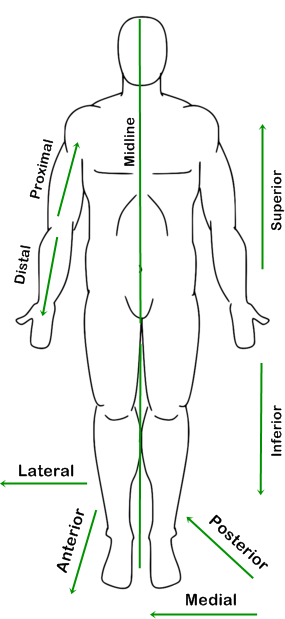Reading Time:
Overview
In anatomy it is important to understand key descriptive terms to help identify location of structures. Various adjectives, arranged as pairs of opposites, describe the relationship of parts of the body or compare the position of two structures relative to each other. Some of these terms are specific for comparisons made in the anatomical position.
Superior/Cranial and Inferior/Caudal
Superior refers to a structure that is nearer the vertex, the topmost point of the cranium.
Cranial relates to the cranium and is a useful directional term, meaning toward the head or cranium.
Inferior refers to a structure that is situated nearer the sole of the foot.
Caudal is a useful directional term that means toward the feet or tail region, represented in humans by the coccyx (tail bone), the small bone at the inferior (caudal) end of the vertebral column.
Medial and Lateral
Medial is used to indicate that a structure is nearer to the centre of the body. For example, the 5th digit of the hand (little finger) is medial to the other digits in the anatomical position. Conversely, lateral stipulates that a structure is farther away from the median plane. The 1st digit of the hand (thumb) is lateral to the other digits in the anatomical position.
Anterior (Ventral) and Posterior (Dorsal)
Anterior (ventral) denotes the front surface of the body. Posterior (dorsal) denotes the back surface of the body or nearer to the back.
Dorsal and Plantar
The posterior surface of the hands, the feet, and the digits are referred to as the dorsum or the dorsal surface, the surface of the hand and fingers corresponding to the palm is the palmar surface, and the surface of the foot and toes corresponding to the sole is the plantar surface.
Proximal & Distal
Proximal and distal are used when contrasting positions nearer to or farther from the attachment of a limb or the central aspect of a linear structure, respectively. Proximal means close to and distal further away.
Key Images

Key Info
Cranial and caudal are rarely used compared to superior and inferior. You can remember that medial is nearer the midline of the body than lateral. Similarly proximal can be remembered as being closer to the body or comparative point if you remember proximity.
Clinical Anatomy
The ear is lateral to the nose.
The nose is medial to the ears.
Pectoralis major lies anterior to pectoralis minor.
The triceps are posterior to biceps brachii.
The shoulder joint is superior to the elbow joint.
The kidneys are inferior to the adrenal glands.
The wrist joint is distal to the elbow joint.
The knee joint is proximal to the ankle joint.
Summary
When learning and describing anatomical structures it is important to be precise. Name the side with any structure and understand common locational terminology as described above. Remember locational terms may be combined, for example: the laceration was located 2cm inferolateral to the left antecubital fossa.
References
RL Drake, W Vogl, AWM Mitchell. Gray's Anatomy for Student (2005). 39th Ed. Ediburgh: Elsevier.
